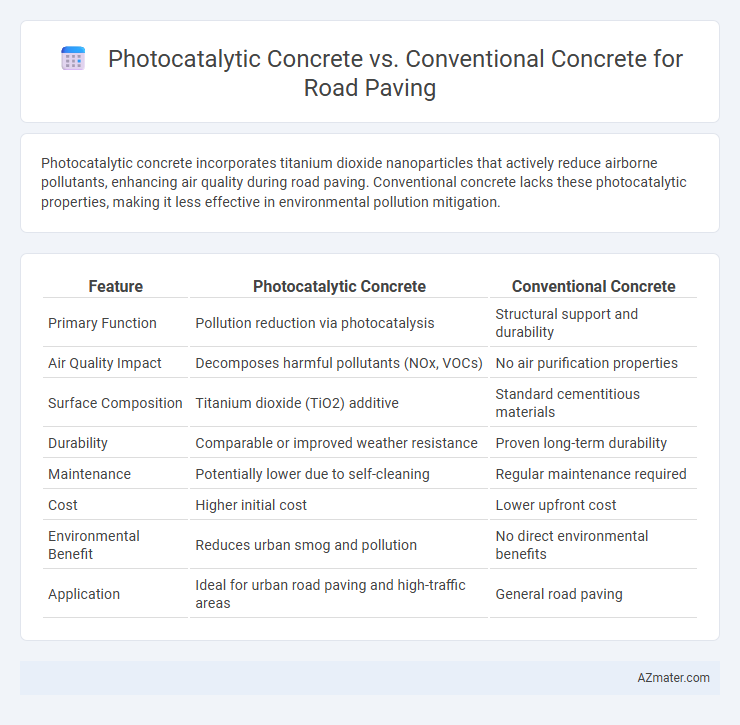Photocatalytic concrete incorporates titanium dioxide nanoparticles that actively reduce airborne pollutants, enhancing air quality during road paving. Conventional concrete lacks these photocatalytic properties, making it less effective in environmental pollution mitigation.
Table of Comparison
| Feature | Photocatalytic Concrete | Conventional Concrete |
|---|---|---|
| Primary Function | Pollution reduction via photocatalysis | Structural support and durability |
| Air Quality Impact | Decomposes harmful pollutants (NOx, VOCs) | No air purification properties |
| Surface Composition | Titanium dioxide (TiO2) additive | Standard cementitious materials |
| Durability | Comparable or improved weather resistance | Proven long-term durability |
| Maintenance | Potentially lower due to self-cleaning | Regular maintenance required |
| Cost | Higher initial cost | Lower upfront cost |
| Environmental Benefit | Reduces urban smog and pollution | No direct environmental benefits |
| Application | Ideal for urban road paving and high-traffic areas | General road paving |
Introduction to Road Paving Materials
Photocatalytic concrete incorporates titanium dioxide (TiO2) nanoparticles that actively reduce air pollutants such as nitrogen oxides (NOx) and volatile organic compounds (VOCs) on road surfaces, enhancing urban air quality. Conventional concrete, primarily composed of cement, aggregates, and water, provides structural integrity and durability but lacks pollutant-degrading properties. Utilizing photocatalytic concrete in road paving combines mechanical strength with environmental remediation, representing an innovative advancement in sustainable infrastructure materials.
What is Photocatalytic Concrete?
Photocatalytic concrete incorporates titanium dioxide (TiO2) nanoparticles that activate under sunlight to break down pollutants, improving air quality by reducing nitrogen oxides (NOx) and volatile organic compounds (VOCs) on road surfaces. Unlike conventional concrete, which primarily provides structural support, photocatalytic concrete offers environmental benefits through its self-cleaning and pollution-degrading properties. This innovative material enhances urban sustainability by mitigating smog and lowering maintenance costs due to its ability to resist dirt and organic stains.
Characteristics of Conventional Concrete
Conventional concrete for road paving typically consists of cement, water, fine and coarse aggregates, and sometimes admixtures to enhance performance. It offers high compressive strength, durability, and resistance to weathering but lacks inherent self-cleaning or pollutant-degrading properties. Its surface can accumulate dirt, oil, and other contaminants over time, leading to increased maintenance and reduced aesthetic appeal.
Environmental Impact Comparison
Photocatalytic concrete significantly reduces air pollution by breaking down nitrogen oxides (NOx) and volatile organic compounds (VOCs) through titanium dioxide (TiO2) embedded in its matrix, improving urban air quality compared to conventional concrete. It also minimizes maintenance needs due to its self-cleaning properties, lowering the environmental footprint associated with cleaning and repair. Conventional concrete contributes to higher carbon emissions during production and lacks the pollution-mitigating benefits, making photocatalytic concrete a more sustainable choice for road paving.
Air Pollution Reduction: Photocatalytic Benefits
Photocatalytic concrete incorporates titanium dioxide, which activates under sunlight to break down harmful pollutants such as nitrogen oxides (NOx) and volatile organic compounds (VOCs), significantly reducing urban air pollution. Conventional concrete lacks this reactive property, causing it to contribute passively to pollutant accumulation without degradation. Utilizing photocatalytic concrete for road paving minimizes smog formation and improves air quality around traffic-dense areas, offering a sustainable solution for combating vehicle emissions.
Durability and Longevity Analysis
Photocatalytic concrete incorporates titanium dioxide, enabling it to break down pollutants and resist surface degradation, significantly enhancing durability compared to conventional concrete. Studies show photocatalytic concrete maintains structural integrity longer under harsh weather and heavy traffic conditions, reducing maintenance needs and extending pavement lifespan by up to 30%. Conventional concrete lacks these self-cleaning and pollutant-degrading properties, often leading to faster deterioration and more frequent repairs over time.
Cost Considerations and Economic Feasibility
Photocatalytic concrete, embedded with titanium dioxide, typically incurs 20-30% higher initial costs than conventional concrete due to advanced material processing and specialized additives. Long-term economic feasibility improves through reduced maintenance and environmental benefits, as its self-cleaning and air-purifying properties mitigate pollution-related damages and lower urban heat effects, potentially extending pavement life by 15-20%. Conventional concrete remains cheaper upfront but often results in higher lifecycle expenses from more frequent repairs and environmental degradation impacts.
Maintenance Requirements and Lifespan
Photocatalytic concrete incorporates titanium dioxide, enabling it to break down pollutants and reduce surface grime, which significantly lowers maintenance requirements compared to conventional concrete that lacks self-cleaning properties. The photocatalytic reaction helps maintain surface integrity and aesthetic quality, potentially extending the lifespan of road pavements by mitigating damage from pollutants and organic matter. Conventional concrete typically experiences more frequent maintenance cycles due to staining and wear, which can accelerate deterioration and reduce overall service life.
Case Studies and Real-world Applications
Photocatalytic concrete, embedded with titanium dioxide, demonstrates significant air pollutant reduction in urban road paving, as evidenced by the successful implementation in Brescia, Italy, where NOx levels decreased by up to 60%. In contrast, conventional concrete lacks this ability, primarily serving structural purposes without environmental benefits. Real-world case studies reveal that photocatalytic concrete contributes to improved air quality and surface self-cleaning, offering a sustainable alternative for roadway infrastructure.
Future Prospects in Sustainable Road Paving
Photocatalytic concrete incorporates titanium dioxide to reduce air pollutants by breaking down nitrogen oxides and organic compounds, offering significant advantages for urban road paving sustainability. Its ability to improve air quality and self-cleaning properties enhances long-term maintenance efficiency compared to conventional concrete, which lacks these environmental benefits. Future prospects for photocatalytic concrete in sustainable road paving emphasize expanding applications in smart city infrastructure and integrating with carbon capture technologies to further reduce the carbon footprint of transportation networks.

Infographic: Photocatalytic concrete vs Conventional concrete for Road paving
 azmater.com
azmater.com